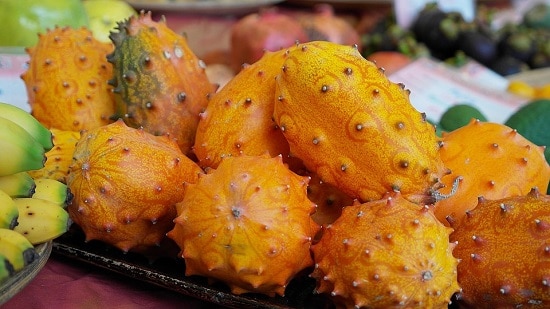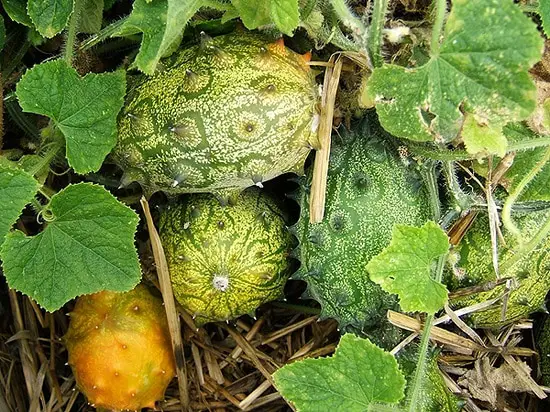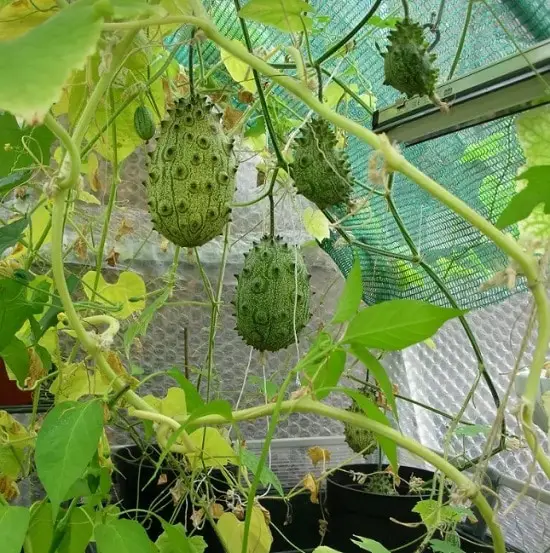Learn How to Grow Kiwano Melon in pots and gardens and have a flavor of four fruits in this one decorative spiky horned melon.
You can grow this fruit in your garden (and in pots as well) when the warm weather arrives, and all the possible threats of the last frost have passed. For this, you’ll need to read this How to Grow Kiwano Melon guide. You can also try it as an experimental crop in your patio, balcony, or rooftop garden.
USDA Hardiness Zones: 10 and Above
Soil pH: Slightly Acidic to Neutral
What is Kiwano Melon?

The appearance of Hornmelon or Kiwano melon resembles a small pumpkin, jagged bitter melon, or cucumber. The vine thrives either on the ground or clings to something in an upward direction. Its heart-shaped leaves are dark green in color and the plant grows long up to 15 feet in length in natural climates but in home gardens, it grows up to 5-10 feet.
Like other cucumber family plants, it has tendrils, which support the growth by clinging to adjacent objects. Each plant has male and female flowers, and only the female flowers have fruits.
The fruit grows in the thick yellow-orange crust with prickly spines and can be 10 to 15 cm long with an elliptical shape. The inside of its fruit contains lime-green, jelly-like flesh that has a flavor similar to cucumber, lime or kiwi. This exotic fruit is most commonly described as a sweet cucumber in taste.
Growing Regions of Kiwano Melons

Kiwano belongs to the hot and semi-arid climates of central and southern Africa. This refreshing fruit is eaten raw, as a snack, or in salads in countries like Zimbabwe. It is mainly cultivated in Africa as a food crop. Whereas, in Australia, in some parts, it’s considered a weed. It’s also grown in Israel and Portugal as an ornamental fruit.
Propagating Kiwano Melon
Start sowing seeds in the spring, when the temperature starts to stay above 54 F (12 C). If you’re growing it in a warm climate, late winter and spring is the best time. In fact, you can grow it almost year-round in frost-free climates by successive sowing.
The ideal seed germination temperature is between 54-93 F (12-34 C). Sprinkle seeds directly into the growing bed or desired container, since they don’t transplant well. Cover them 1/2 inch deep with a layer of soil.
Also, keep the soil slightly moist until germination takes place. Within 1-2 weeks, seeds will begin to sprout. Once they’ve grown a bit, maintain the spacing of 14-18 inches between each one.
Note: For a good germination rate, maintain the temperature around 59-95 F (15-35 C). It may vary according to the climate and quality of seeds, and they will sprout within 1-3 weeks.
Growing Kiwano Melon in Pots

If you have a rooftop or balcony garden, then growing kiwano melon in pots is possible. Plant seeds in a large pot when the danger of frost has passed and the soil is sufficiently warm.
Sow 3-4 seeds directly in a pot when the temperature is more than 55 F (13 C) in a large 15-18 inches deep pot. Since it spreads vigorously, provide support of a trellis that’s at least 5-6 feet tall. Place the pot in a sunny spot and water it moderately.
Note: You can plant Kiwano melon indoors and transfer it to the garden when seedlings emerge in two or three true leaves, and the temperature is above 60 F (15 C) constantly.
Check out our article on growing Bitter Melon here!
Requirements for Growing Kiwano melon
Location
Plant Kiwano melon where it receives full sunlight, keep in mind that full sun exposure is a must for growth and productivity. Provide good air circulation but avoid windy places.
Soil
Kiwano prefers well-drained, loamy soil, with a pH of around 6-6.5. If you are growing it in a pot, ensure that it has proper drainage holes. Add a lot of organic matter like compost or well-rotted manure to the potting soil to enrich it.
Watering
While the kiwano melon is mildly drought tolerant, it’s better to water it regularly and deeply. Allow the topsoil to dry out between watering, especially in containers. Also, avoid overhead watering to prevent wetting the foliage. When the fruit is about to ripen, reduce watering, as it enhances the taste of the melon.
Kiwano Melon Care

Fertilizer
Feed the plant with general-purpose fertilizer like 10-10-10, once every 2-3 weeks. When the plant begins to produce flowers and the fruits start to appear, feed it with less nitrogen, a fertilizer of 1-2-2 NPK ratio should be fine.
If you’re an organic gardener, do side-dressing with compost or manure.
Mulching
Use organic mulch like wood clippings or straw over the base of the plant, as it helps in preserving moisture and control the growth of weed.
Pest and Diseases
Kiwano horned melons are tolerant of many root-knot nematodes, but they may get affected by squash mosaic virus and fusarium wilt. If you notice weeds remove them by hand, as it will help in eliminating diseases such as tobacco ringspot virus and cucumber mosaic virus.
In your container garden, you’ll need to take care of common pests that affect your other plants, such as aphids and whiteflies. In diseases, powdery mildew can be harmful to it. To avoid, provide proper air circulation and don’t wet the foliage.
Harvesting and Storage
It will take around 4 months from sowing seeds to harvesting Kiwano melons. Keep in mind to wear gloves before harvesting the fruit, as the pointed spikes may hurt the skin.
Either you can eat them raw by scooping out the lime-green flesh, or you can toss this fruit in salads. As this fruit has a long shelf life, you can keep them for 3-4 months for decor in a cool and dry place.
Check out our article on Growing Watermelons in containers here!




Where can I buy seeds in Israel?
I can maybe send you some from Australia if you would;d like to make contact with me. regards Daryl
Will they grow along side passion fruit?
Yes , I do it in Goa, south india